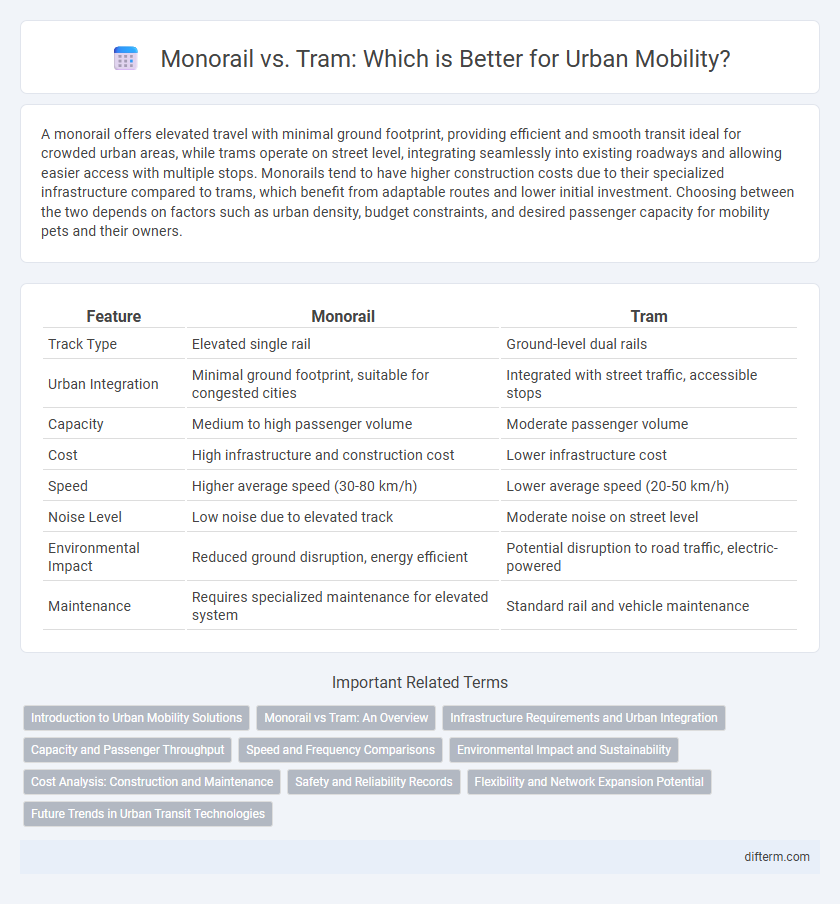A monorail offers elevated travel with minimal ground footprint, providing efficient and smooth transit ideal for crowded urban areas, while trams operate on street level, integrating seamlessly into existing roadways and allowing easier access with multiple stops. Monorails tend to have higher construction costs due to their specialized infrastructure compared to trams, which benefit from adaptable routes and lower initial investment. Choosing between the two depends on factors such as urban density, budget constraints, and desired passenger capacity for mobility pets and their owners.
Table of Comparison
| Feature | Monorail | Tram |
|---|---|---|
| Track Type | Elevated single rail | Ground-level dual rails |
| Urban Integration | Minimal ground footprint, suitable for congested cities | Integrated with street traffic, accessible stops |
| Capacity | Medium to high passenger volume | Moderate passenger volume |
| Cost | High infrastructure and construction cost | Lower infrastructure cost |
| Speed | Higher average speed (30-80 km/h) | Lower average speed (20-50 km/h) |
| Noise Level | Low noise due to elevated track | Moderate noise on street level |
| Environmental Impact | Reduced ground disruption, energy efficient | Potential disruption to road traffic, electric-powered |
| Maintenance | Requires specialized maintenance for elevated system | Standard rail and vehicle maintenance |
Introduction to Urban Mobility Solutions
Monorails and trams represent distinct urban mobility solutions designed to enhance city transportation efficiency. Monorails operate on elevated single rails, reducing ground-level congestion and offering rapid transit in densely populated areas. Trams run on street-level tracks, integrating seamlessly with urban landscapes and providing flexible stops that support local commuting needs.
Monorail vs Tram: An Overview
Monorails operate on a single rail, typically elevated, offering a compact and efficient solution for urban transit with minimal ground space usage. Trams run on dual rails embedded in streets, providing flexible routes and easy access but often facing congestion in mixed traffic. Monorails excel in reducing traffic interference and rapid transit times, while trams provide frequent stops and integration with pedestrian zones.
Infrastructure Requirements and Urban Integration
Monorails require less ground-level space due to their elevated tracks, minimizing disruption in dense urban areas, whereas trams need extensive street-level infrastructure, including tracks and power lines embedded in existing roads. Urban integration for monorails tends to be more seamless in congested cities by avoiding traffic interference, while trams enhance street-level accessibility and can better support pedestrian-friendly environments. Infrastructure costs for monorails are typically higher upfront but benefit from reduced land acquisition challenges compared to tram systems that demand significant road modifications.
Capacity and Passenger Throughput
Monorails typically offer higher passenger throughput compared to trams due to their elevated tracks, which reduce street-level congestion and allow for faster, uninterrupted travel. Tram systems, while often more flexible in urban environments, generally have lower capacity per vehicle and face delays from mixed traffic conditions. Effective transit planning must evaluate the anticipated passenger volume and infrastructure constraints to determine the optimal choice between monorail and tram systems.
Speed and Frequency Comparisons
Monorails typically achieve higher speeds, averaging 40 to 60 mph, compared to trams, which operate around 20 to 30 mph due to street-level traffic constraints. Monorail systems benefit from dedicated tracks that enable more consistent frequency, often running every 3 to 5 minutes, whereas tram frequency varies between 5 to 10 minutes depending on urban congestion. The elevated nature of monorails reduces delays, making them more reliable for rapid transit in dense metropolitan areas.
Environmental Impact and Sustainability
Monorails produce lower greenhouse gas emissions per passenger kilometer compared to trams due to their electric propulsion and elevated tracks that reduce land use disruption. Trams, while also electric, often require extensive ground-level infrastructure and can contribute to habitat fragmentation and increased urban runoff. Sustainable urban mobility favors monorails for their minimal environmental footprint and capacity to integrate seamlessly into dense cityscapes without extensive ground disturbance.
Cost Analysis: Construction and Maintenance
Monorail systems typically incur higher initial construction costs due to specialized infrastructure and elevated tracks, while trams benefit from lower expenses by utilizing existing roadways and simpler rail installations. Maintenance for monorails involves complex, proprietary components requiring specialized technicians, leading to increased long-term operational costs compared to trams, whose maintenance can often leverage existing urban transit resources. Evaluating the total cost of ownership, trams generally offer more cost-effective solutions for urban mobility projects with constrained budgets and dense street networks.
Safety and Reliability Records
Monorails exhibit higher safety records due to elevated tracks reducing collision risks and pedestrian interference, while trams face more frequent accidents involving road traffic and pedestrians. Reliability data shows monorails benefit from dedicated guideways and automated controls, resulting in fewer delays and mechanical issues compared to trams operating in mixed traffic conditions. Transport authorities favor monorails for urban environments requiring consistent schedules and enhanced safety standards.
Flexibility and Network Expansion Potential
Monorails offer elevated tracks that minimize ground-level disruptions but have limited flexibility in route adjustments compared to trams, which can easily share roadways and adapt to urban layouts. Trams provide higher network expansion potential through integration with existing street infrastructure, allowing for incremental additions and route modifications. Monorail systems require substantial upfront investment for guideway construction, restricting rapid expansion relative to the more adaptable and cost-effective tram networks.
Future Trends in Urban Transit Technologies
Monorail systems are gaining traction in urban transit due to their elevated tracks, which reduce ground-level congestion and offer faster, uninterrupted travel compared to trams. Emerging technologies such as automation, energy-efficient propulsion, and smart infrastructure integration are set to enhance the operational efficiency of both monorails and trams. Future urban mobility solutions will increasingly prioritize sustainability, real-time data analytics, and seamless multimodal connectivity to meet growing demands for efficient, eco-friendly transportation.
monorail vs tram Infographic

 difterm.com
difterm.com